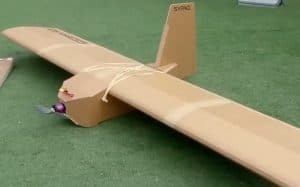An Australian company, Sypaq, sells waxed cardboard UAVs (unmanned aerial vehicles/drones) capable of transporting more than ten pounds of explosive (and other recon/camera/commo payloads) to hit targets 100 miles distant.
It’s known as the Corvo Precision Payload Delivery System and the government of Australia is providing 100 Corvos a month to the Ukrainians as part of a $20MM aid package.
The device is assembled with rubberbands and sticks, and is propelled by a battery powered motor. Looks like something Ikea would sell, no?
It has zero radar signature and costs $3,500 though it will cost much less in bulk in the future.
Is this cost effective, Big Red Car?
Here are the facts, you decide.
The Ukrainians (SBU, the Security Service) claim they unleashed a raid of 16 such weapons and destroyed:
1 Mig-29 fighter jet,
4 Su-30 fighter jets,
2 Pantsir missile launchers, and
the radar component of a S-300 air defense radar.
These are all delicate targets and a small amount of explosive can destroy them or light them afire. The target was a military airport in Kursk located 55 miles from the Ukrainian border.
Put a pencil to those Russian assets (a Pantsir missile launcher costs $15MM plus up to 12 rockets and a Su-30 fighter jet costs $40MM) and multiply 16 cardboard UAVs at $3,500/each and get an idea of the cost effectiveness of that kind of exchange.
What’re the tactics, Big Red Car?
Nobody really knows, but the thesis is the 16 Corvos were unleashed in a “swarm” that overwhelmed the Russian Pantsir anti-aircraft launcher radars. The Ukrainians say some of the swarm were dummy devices with no explosives and were used as bait to distract the Pantsir rocket launchers’ radar.
A Pantsir can only track 2 targets at a time though it has a dozen rockets to fire if it can find a target.
[Fun fact: In June 2020, the American CIA obtained/bought a Pantsir from rebel Libya forces and stealthily removed it from Libya to the US, so you can bet the Americans have reverse engineered that baby and provided that intel to the Ukrainians and the Australians.]
So, it is believed the 16 UAVs overwhelmed the Pantsir’s tracking capabilities — even if they could track the cardboard Corvos which is doubtful.
Bottom line it, Big Red Car
War creates innovation and in this instance a waxed cardboard, battery powered, electric engine in an UAV carrying a small amount of explosive can destroy millions of rubles of Russian gear. Wow!
Can you imagine that somebody can make that Corvo for about $100? I can.
But, hey, what the Hell do I really know anyway? I’m just a Big Red Car and I’m made of good old fashioned sheet metal, not waxed cardboard.

